1/
Why can furosemide improve dyspnea/pulmonary edema from acute congestive heart failure within minutes of administration?
The answer does not involve diuresis.
#medtwitter #tweetorial
Why can furosemide improve dyspnea/pulmonary edema from acute congestive heart failure within minutes of administration?
The answer does not involve diuresis.
#medtwitter #tweetorial
2/
Furosemide (aka Lasix) was introduced as a loop diuretic in 1964.
It was soon observed that treatment of pulmonary edema w/ furosemide led to rapid improvement in dyspnea, sometimes before diuresis.
The mechanism of this effect was unknown.
#b1">https://www.ncbi.nlm.nih.gov/pmc/articles/PMC2014966/ #b1">https://www.ncbi.nlm.nih.gov/pmc/artic...
Furosemide (aka Lasix) was introduced as a loop diuretic in 1964.
It was soon observed that treatment of pulmonary edema w/ furosemide led to rapid improvement in dyspnea, sometimes before diuresis.
The mechanism of this effect was unknown.
#b1">https://www.ncbi.nlm.nih.gov/pmc/articles/PMC2014966/ #b1">https://www.ncbi.nlm.nih.gov/pmc/artic...
3/
The first clue as to why came in a subsequent study in 1973.
It was noted that left ventricular (LV) filling pressures https://abs.twimg.com/emoji/v2/... draggable="false" alt="⬇️" title="Pfeil nach unten" aria-label="Emoji: Pfeil nach unten"> within 5 minutes of administering furosemide to patients w/ heart failure.
https://abs.twimg.com/emoji/v2/... draggable="false" alt="⬇️" title="Pfeil nach unten" aria-label="Emoji: Pfeil nach unten"> within 5 minutes of administering furosemide to patients w/ heart failure.
https://pubmed.ncbi.nlm.nih.gov/4697939/ ">https://pubmed.ncbi.nlm.nih.gov/4697939/&...
The first clue as to why came in a subsequent study in 1973.
It was noted that left ventricular (LV) filling pressures
https://pubmed.ncbi.nlm.nih.gov/4697939/ ">https://pubmed.ncbi.nlm.nih.gov/4697939/&...
4/
In the same experiment, venous capacitance increased almost immediately after furosemide was given, while diuresis didn& #39;t start until 30 minutes later.
 https://abs.twimg.com/emoji/v2/... draggable="false" alt="🔑" title="Schlüssel" aria-label="Emoji: Schlüssel">Venodilation seemed to be the cause of the rapid fall in LV filling pressure.
https://abs.twimg.com/emoji/v2/... draggable="false" alt="🔑" title="Schlüssel" aria-label="Emoji: Schlüssel">Venodilation seemed to be the cause of the rapid fall in LV filling pressure.
https://pubmed.ncbi.nlm.nih.gov/4697939/ ">https://pubmed.ncbi.nlm.nih.gov/4697939/&...
In the same experiment, venous capacitance increased almost immediately after furosemide was given, while diuresis didn& #39;t start until 30 minutes later.
https://pubmed.ncbi.nlm.nih.gov/4697939/ ">https://pubmed.ncbi.nlm.nih.gov/4697939/&...
5/
What, then, is the mechanism by which furosemide induces venodilation?
In a study in anuric dogs, pre-treatment w/ the NSAID indomethacin before furosemide prevented reduction in pulmonary capillary wedge pressure.
https://pubmed.ncbi.nlm.nih.gov/874816/ ">https://pubmed.ncbi.nlm.nih.gov/874816/&q...
What, then, is the mechanism by which furosemide induces venodilation?
In a study in anuric dogs, pre-treatment w/ the NSAID indomethacin before furosemide prevented reduction in pulmonary capillary wedge pressure.
https://pubmed.ncbi.nlm.nih.gov/874816/ ">https://pubmed.ncbi.nlm.nih.gov/874816/&q...
6/
NSAIDs like indomethacin inhibit cyclooxygenase-1,2, blocking production of prostaglandins.
Prostaglandins have many physiologic effects, including acting as potent vaso/venodilators.
https://pubmed.ncbi.nlm.nih.gov/24900965/ ">https://pubmed.ncbi.nlm.nih.gov/24900965/...
NSAIDs like indomethacin inhibit cyclooxygenase-1,2, blocking production of prostaglandins.
Prostaglandins have many physiologic effects, including acting as potent vaso/venodilators.
https://pubmed.ncbi.nlm.nih.gov/24900965/ ">https://pubmed.ncbi.nlm.nih.gov/24900965/...
7/
 https://abs.twimg.com/emoji/v2/... draggable="false" alt="🔑" title="Schlüssel" aria-label="Emoji: Schlüssel">Since indomethacin inhibited furosemide& #39;s non-diuretic effects on LV filling pressure, this implicated prostaglandins as the mediators of furosemide-induced venodilation.
https://abs.twimg.com/emoji/v2/... draggable="false" alt="🔑" title="Schlüssel" aria-label="Emoji: Schlüssel">Since indomethacin inhibited furosemide& #39;s non-diuretic effects on LV filling pressure, this implicated prostaglandins as the mediators of furosemide-induced venodilation.
8/
A subsequent study confirmed venodilation from furosemide, by way of prostaglandins.
Arterial + venous blood flow was recorded after furosemide infusion. While arteries didn& #39;t react, veins dilated ~70%.
 https://abs.twimg.com/emoji/v2/... draggable="false" alt="💡" title="Elektrische Glühbirne" aria-label="Emoji: Elektrische Glühbirne">This effect was blocked by indomethacin.
https://abs.twimg.com/emoji/v2/... draggable="false" alt="💡" title="Elektrische Glühbirne" aria-label="Emoji: Elektrische Glühbirne">This effect was blocked by indomethacin.
https://pubmed.ncbi.nlm.nih.gov/9323071/ ">https://pubmed.ncbi.nlm.nih.gov/9323071/&...
A subsequent study confirmed venodilation from furosemide, by way of prostaglandins.
Arterial + venous blood flow was recorded after furosemide infusion. While arteries didn& #39;t react, veins dilated ~70%.
https://pubmed.ncbi.nlm.nih.gov/9323071/ ">https://pubmed.ncbi.nlm.nih.gov/9323071/&...
9/
A follow-up question: how does furosemide induce prostaglandin-mediated venodilation?
The leading theory: furosemide https://abs.twimg.com/emoji/v2/... draggable="false" alt="⬆️" title="Pfeil nach oben" aria-label="Emoji: Pfeil nach oben">endothelial cell production of prostaglandins (as occurred below in bovine endothelial cells), but isn& #39;t itself a direct venodilator.
https://abs.twimg.com/emoji/v2/... draggable="false" alt="⬆️" title="Pfeil nach oben" aria-label="Emoji: Pfeil nach oben">endothelial cell production of prostaglandins (as occurred below in bovine endothelial cells), but isn& #39;t itself a direct venodilator.
https://pubmed.ncbi.nlm.nih.gov/7996475/ ">https://pubmed.ncbi.nlm.nih.gov/7996475/&...
A follow-up question: how does furosemide induce prostaglandin-mediated venodilation?
The leading theory: furosemide
https://pubmed.ncbi.nlm.nih.gov/7996475/ ">https://pubmed.ncbi.nlm.nih.gov/7996475/&...
10/
Before wrapping up, a couple of caveats:
 https://abs.twimg.com/emoji/v2/... draggable="false" alt="🔹" title="Kleine blaue Raute" aria-label="Emoji: Kleine blaue Raute">The exact mechanism of how furosemide stimulates prostaglandin production isn& #39;t known
https://abs.twimg.com/emoji/v2/... draggable="false" alt="🔹" title="Kleine blaue Raute" aria-label="Emoji: Kleine blaue Raute">The exact mechanism of how furosemide stimulates prostaglandin production isn& #39;t known
 https://abs.twimg.com/emoji/v2/... draggable="false" alt="🔹" title="Kleine blaue Raute" aria-label="Emoji: Kleine blaue Raute">Furosemide also induces nitric oxide synthesis, but this doesn& #39;t seem to be the primary source of venodilation https://pubmed.ncbi.nlm.nih.gov/9323071/ ">https://pubmed.ncbi.nlm.nih.gov/9323071/&...
https://abs.twimg.com/emoji/v2/... draggable="false" alt="🔹" title="Kleine blaue Raute" aria-label="Emoji: Kleine blaue Raute">Furosemide also induces nitric oxide synthesis, but this doesn& #39;t seem to be the primary source of venodilation https://pubmed.ncbi.nlm.nih.gov/9323071/ ">https://pubmed.ncbi.nlm.nih.gov/9323071/&...
Before wrapping up, a couple of caveats:
11/
Let& #39;s close with a fascinating clinical correlate.
Inhaled furosemide has been studied as treatment for air hunger in lung cancer, as well as dyspnea that was induced in healthy subjects.
This may involve modulation of pulmonary J-receptor output.
https://pubmed.ncbi.nlm.nih.gov/16935035/ ">https://pubmed.ncbi.nlm.nih.gov/16935035/...
Let& #39;s close with a fascinating clinical correlate.
Inhaled furosemide has been studied as treatment for air hunger in lung cancer, as well as dyspnea that was induced in healthy subjects.
This may involve modulation of pulmonary J-receptor output.
https://pubmed.ncbi.nlm.nih.gov/16935035/ ">https://pubmed.ncbi.nlm.nih.gov/16935035/...
12/
But even more incredibly, furosemide appears to be a bronchodilator.
When rat airways were pre-constricted w/ methacholine or serotonin, treatment w/ furosemide significantly decreased bronchoconstriction.
https://pubmed.ncbi.nlm.nih.gov/9087943/ ">https://pubmed.ncbi.nlm.nih.gov/9087943/&...
But even more incredibly, furosemide appears to be a bronchodilator.
When rat airways were pre-constricted w/ methacholine or serotonin, treatment w/ furosemide significantly decreased bronchoconstriction.
https://pubmed.ncbi.nlm.nih.gov/9087943/ ">https://pubmed.ncbi.nlm.nih.gov/9087943/&...
13/
Incubation with indomethacin blocked furosemide& #39;s effect on airway tone.
 https://abs.twimg.com/emoji/v2/... draggable="false" alt="🔑" title="Schlüssel" aria-label="Emoji: Schlüssel">Amazingly, like venodilation, furosemide& #39;s apparent ability to bronchodilate seems to be mediated by prostaglandins.
https://abs.twimg.com/emoji/v2/... draggable="false" alt="🔑" title="Schlüssel" aria-label="Emoji: Schlüssel">Amazingly, like venodilation, furosemide& #39;s apparent ability to bronchodilate seems to be mediated by prostaglandins.
https://pubmed.ncbi.nlm.nih.gov/9087943/ ">https://pubmed.ncbi.nlm.nih.gov/9087943/&...
Incubation with indomethacin blocked furosemide& #39;s effect on airway tone.
https://pubmed.ncbi.nlm.nih.gov/9087943/ ">https://pubmed.ncbi.nlm.nih.gov/9087943/&...
14/
 https://abs.twimg.com/emoji/v2/... draggable="false" alt="💡" title="Elektrische Glühbirne" aria-label="Emoji: Elektrische Glühbirne">Furosemide rapidly
https://abs.twimg.com/emoji/v2/... draggable="false" alt="💡" title="Elektrische Glühbirne" aria-label="Emoji: Elektrische Glühbirne">Furosemide rapidly https://abs.twimg.com/emoji/v2/... draggable="false" alt="⬇️" title="Pfeil nach unten" aria-label="Emoji: Pfeil nach unten">LV filling pressures in acute heart failure, via venodilation and independent of diuresis
https://abs.twimg.com/emoji/v2/... draggable="false" alt="⬇️" title="Pfeil nach unten" aria-label="Emoji: Pfeil nach unten">LV filling pressures in acute heart failure, via venodilation and independent of diuresis
 https://abs.twimg.com/emoji/v2/... draggable="false" alt="💡" title="Elektrische Glühbirne" aria-label="Emoji: Elektrische Glühbirne">Purported mechanism =
https://abs.twimg.com/emoji/v2/... draggable="false" alt="💡" title="Elektrische Glühbirne" aria-label="Emoji: Elektrische Glühbirne">Purported mechanism = https://abs.twimg.com/emoji/v2/... draggable="false" alt="⬆️" title="Pfeil nach oben" aria-label="Emoji: Pfeil nach oben">endothelial cell prostaglandin production
https://abs.twimg.com/emoji/v2/... draggable="false" alt="⬆️" title="Pfeil nach oben" aria-label="Emoji: Pfeil nach oben">endothelial cell prostaglandin production
 https://abs.twimg.com/emoji/v2/... draggable="false" alt="💡" title="Elektrische Glühbirne" aria-label="Emoji: Elektrische Glühbirne">Furosemide also is a bronchodilator, likely via
https://abs.twimg.com/emoji/v2/... draggable="false" alt="💡" title="Elektrische Glühbirne" aria-label="Emoji: Elektrische Glühbirne">Furosemide also is a bronchodilator, likely via  https://abs.twimg.com/emoji/v2/... draggable="false" alt="⬆️" title="Pfeil nach oben" aria-label="Emoji: Pfeil nach oben">prostaglandins in a similar fashion
https://abs.twimg.com/emoji/v2/... draggable="false" alt="⬆️" title="Pfeil nach oben" aria-label="Emoji: Pfeil nach oben">prostaglandins in a similar fashion

 Read on Twitter
Read on Twitter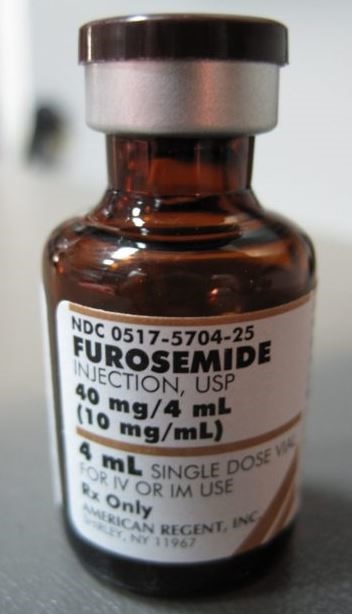

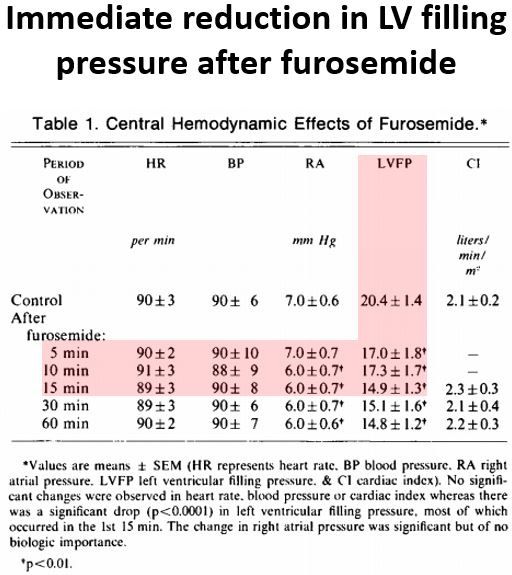 within 5 minutes of administering furosemide to patients w/ heart failure. https://pubmed.ncbi.nlm.nih.gov/4697939/&..." title="3/The first clue as to why came in a subsequent study in 1973.It was noted that left ventricular (LV) filling pressures https://abs.twimg.com/emoji/v2/... draggable="false" alt="⬇️" title="Pfeil nach unten" aria-label="Emoji: Pfeil nach unten"> within 5 minutes of administering furosemide to patients w/ heart failure. https://pubmed.ncbi.nlm.nih.gov/4697939/&..." class="img-responsive" style="max-width:100%;"/>
within 5 minutes of administering furosemide to patients w/ heart failure. https://pubmed.ncbi.nlm.nih.gov/4697939/&..." title="3/The first clue as to why came in a subsequent study in 1973.It was noted that left ventricular (LV) filling pressures https://abs.twimg.com/emoji/v2/... draggable="false" alt="⬇️" title="Pfeil nach unten" aria-label="Emoji: Pfeil nach unten"> within 5 minutes of administering furosemide to patients w/ heart failure. https://pubmed.ncbi.nlm.nih.gov/4697939/&..." class="img-responsive" style="max-width:100%;"/>
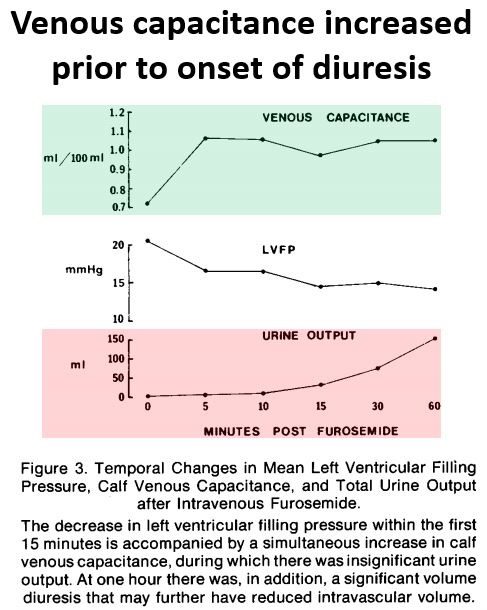 Venodilation seemed to be the cause of the rapid fall in LV filling pressure. https://pubmed.ncbi.nlm.nih.gov/4697939/&..." title="4/In the same experiment, venous capacitance increased almost immediately after furosemide was given, while diuresis didn& #39;t start until 30 minutes later.https://abs.twimg.com/emoji/v2/... draggable="false" alt="🔑" title="Schlüssel" aria-label="Emoji: Schlüssel">Venodilation seemed to be the cause of the rapid fall in LV filling pressure. https://pubmed.ncbi.nlm.nih.gov/4697939/&..." class="img-responsive" style="max-width:100%;"/>
Venodilation seemed to be the cause of the rapid fall in LV filling pressure. https://pubmed.ncbi.nlm.nih.gov/4697939/&..." title="4/In the same experiment, venous capacitance increased almost immediately after furosemide was given, while diuresis didn& #39;t start until 30 minutes later.https://abs.twimg.com/emoji/v2/... draggable="false" alt="🔑" title="Schlüssel" aria-label="Emoji: Schlüssel">Venodilation seemed to be the cause of the rapid fall in LV filling pressure. https://pubmed.ncbi.nlm.nih.gov/4697939/&..." class="img-responsive" style="max-width:100%;"/>
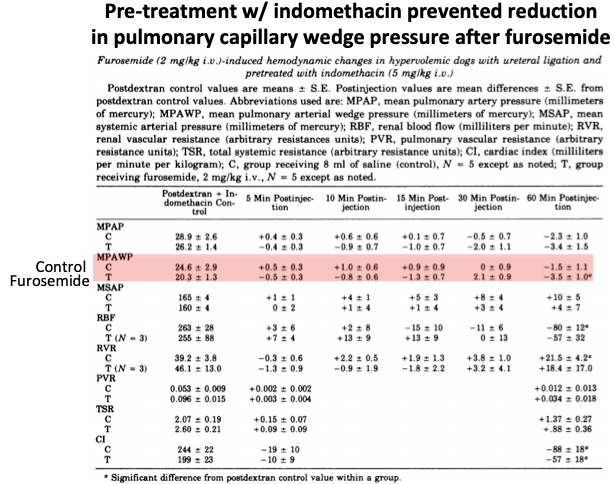
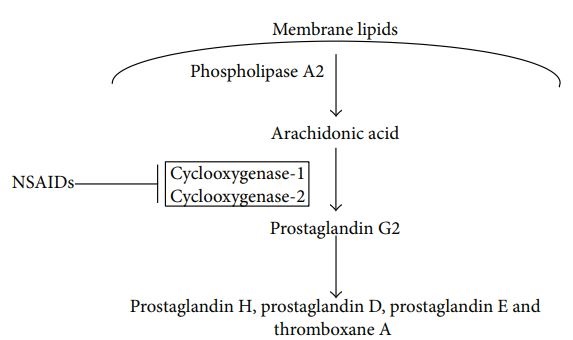
 This effect was blocked by indomethacin. https://pubmed.ncbi.nlm.nih.gov/9323071/&..." title="8/A subsequent study confirmed venodilation from furosemide, by way of prostaglandins.Arterial + venous blood flow was recorded after furosemide infusion. While arteries didn& #39;t react, veins dilated ~70%. https://abs.twimg.com/emoji/v2/... draggable="false" alt="💡" title="Elektrische Glühbirne" aria-label="Emoji: Elektrische Glühbirne">This effect was blocked by indomethacin. https://pubmed.ncbi.nlm.nih.gov/9323071/&..." class="img-responsive" style="max-width:100%;"/>
This effect was blocked by indomethacin. https://pubmed.ncbi.nlm.nih.gov/9323071/&..." title="8/A subsequent study confirmed venodilation from furosemide, by way of prostaglandins.Arterial + venous blood flow was recorded after furosemide infusion. While arteries didn& #39;t react, veins dilated ~70%. https://abs.twimg.com/emoji/v2/... draggable="false" alt="💡" title="Elektrische Glühbirne" aria-label="Emoji: Elektrische Glühbirne">This effect was blocked by indomethacin. https://pubmed.ncbi.nlm.nih.gov/9323071/&..." class="img-responsive" style="max-width:100%;"/>
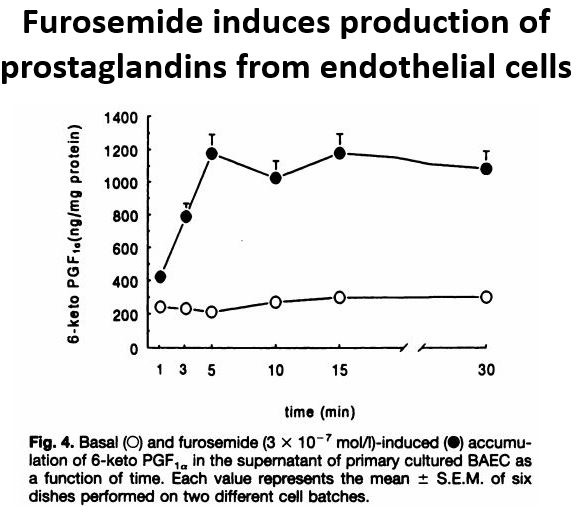 endothelial cell production of prostaglandins (as occurred below in bovine endothelial cells), but isn& #39;t itself a direct venodilator. https://pubmed.ncbi.nlm.nih.gov/7996475/&..." title="9/A follow-up question: how does furosemide induce prostaglandin-mediated venodilation?The leading theory: furosemidehttps://abs.twimg.com/emoji/v2/... draggable="false" alt="⬆️" title="Pfeil nach oben" aria-label="Emoji: Pfeil nach oben">endothelial cell production of prostaglandins (as occurred below in bovine endothelial cells), but isn& #39;t itself a direct venodilator. https://pubmed.ncbi.nlm.nih.gov/7996475/&..." class="img-responsive" style="max-width:100%;"/>
endothelial cell production of prostaglandins (as occurred below in bovine endothelial cells), but isn& #39;t itself a direct venodilator. https://pubmed.ncbi.nlm.nih.gov/7996475/&..." title="9/A follow-up question: how does furosemide induce prostaglandin-mediated venodilation?The leading theory: furosemidehttps://abs.twimg.com/emoji/v2/... draggable="false" alt="⬆️" title="Pfeil nach oben" aria-label="Emoji: Pfeil nach oben">endothelial cell production of prostaglandins (as occurred below in bovine endothelial cells), but isn& #39;t itself a direct venodilator. https://pubmed.ncbi.nlm.nih.gov/7996475/&..." class="img-responsive" style="max-width:100%;"/>
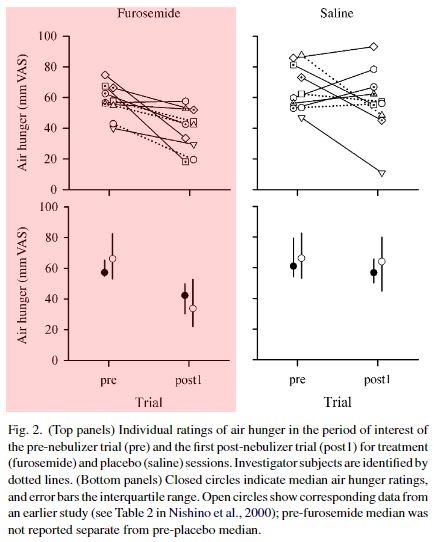
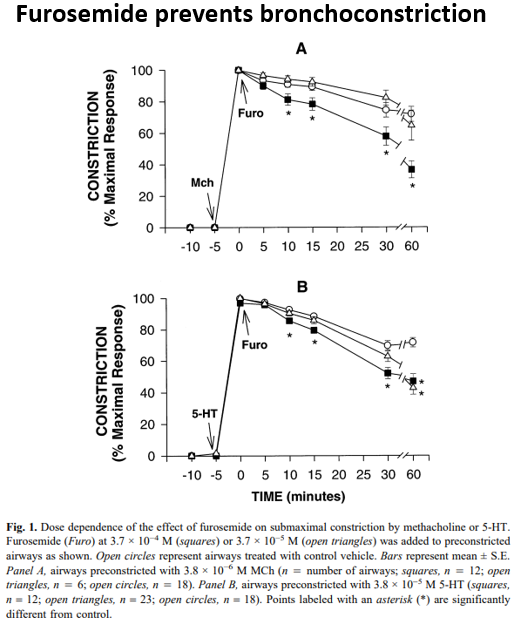
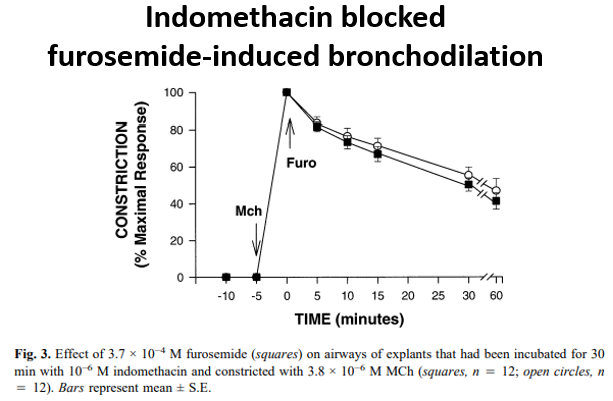 Amazingly, like venodilation, furosemide& #39;s apparent ability to bronchodilate seems to be mediated by prostaglandins. https://pubmed.ncbi.nlm.nih.gov/9087943/&..." title="13/Incubation with indomethacin blocked furosemide& #39;s effect on airway tone.https://abs.twimg.com/emoji/v2/... draggable="false" alt="🔑" title="Schlüssel" aria-label="Emoji: Schlüssel">Amazingly, like venodilation, furosemide& #39;s apparent ability to bronchodilate seems to be mediated by prostaglandins. https://pubmed.ncbi.nlm.nih.gov/9087943/&..." class="img-responsive" style="max-width:100%;"/>
Amazingly, like venodilation, furosemide& #39;s apparent ability to bronchodilate seems to be mediated by prostaglandins. https://pubmed.ncbi.nlm.nih.gov/9087943/&..." title="13/Incubation with indomethacin blocked furosemide& #39;s effect on airway tone.https://abs.twimg.com/emoji/v2/... draggable="false" alt="🔑" title="Schlüssel" aria-label="Emoji: Schlüssel">Amazingly, like venodilation, furosemide& #39;s apparent ability to bronchodilate seems to be mediated by prostaglandins. https://pubmed.ncbi.nlm.nih.gov/9087943/&..." class="img-responsive" style="max-width:100%;"/>


